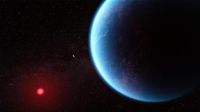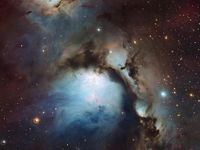The scientific community is abuzz with excitement following the recent publication of data suggesting the potential presence of biosignatures in the atmosphere of the exoplanet K2-18b. Results from the James Webb Space Telescope (JWST) indicate the detection of molecules typically associated with biological activity on Earth, raising significant questions about the possibility of extraterrestrial life.
K2-18b, located 124 light-years away in the constellation Leo, orbits the red dwarf star K2-18, which has only 2.3% of the sun's luminosity. Despite the star's faintness, K2-18b's proximity to it (0.142 AU) results in an equilibrium temperature range of -73°C to +47°C, theoretically allowing for the existence of liquid water on its surface. However, the planet's structure presents a key challenge: with a radius of 2.6 times that of Earth and a mass 8.6 times greater, its average density of 2.67 g/cm³ suggests a thick atmosphere, likely composed of hydrogen and helium, possibly with a global ocean beneath.
The interest in K2-18b surged after earlier observations from JWST in 2023 revealed methane (CH₄) and carbon dioxide (CO₂) in its atmosphere. In April 2025, an international team of astronomers led by Professor Nikku Madhusudhan from the University of Cambridge presented new findings using the MIRI mid-infrared instrument of JWST. The data allowed researchers to reconstruct the atmospheric profile of K2-18b with unprecedented accuracy.
During the planet's transit across its star, the JWST detected light absorption at wavelengths of 3.3–3.5 μm and 7.5–8.5 μm, corresponding to the spectral lines of dimethyl sulfide (DMS) and dimethyl disulfide (DMDS). These compounds are produced exclusively by living organisms on Earth, such as marine phytoplankton, making their presence on K2-18b a compelling argument for biological activity. The concentration of DMS was estimated at 10 parts per million (ppm), a staggering three orders of magnitude higher than Earth's levels of 0.01 ppm.
The statistical significance of this detection reached 3σ, achieved through 15 transit events recorded between 2023 and 2025, each lasting approximately 2.5 hours. In contrast, previous observations with the Hubble Space Telescope in 2019 only confirmed the presence of water vapor with a reliability of 1.5σ. While the current findings are promising, they fall short of the five-sigma threshold required for definitive confirmation, necessitating further observations.
The discovery of DMS and DMDS is viewed as the most convincing evidence to date supporting the hypothesis of biological activity on K2-18b. However, skepticism remains among scientists, with critics highlighting alternative scenarios for the formation of DMS. Professor Hyeseung Lee from the Massachusetts Institute of Technology points out that under high-pressure conditions (estimated at 100–1000 bar at K2-18b's surface) and temperatures above 200°C, reactions between hydrogen sulfide (H₂S) and methane (CH₄) could occur, catalyzed by minerals in a hypothetical ocean. Laboratory experiments simulating such conditions have already demonstrated the formation of DMS without biological processes.
Moreover, photochemical models published in Nature Astronomy in 2024 suggest that ultraviolet radiation from a red dwarf star could trigger a cascade of reactions in the upper atmosphere, leading to the synthesis of complex organic molecules. This adds another layer of complexity to the ongoing debates surrounding K2-18b's potential for supporting life.
Compounding the uncertainty is the question of K2-18b's internal structure. A modeling study led by Dr. Caroline Morais from the University of São Paulo proposes that the planet may be a "water giant," with a silicate and iron core surrounded by a layer of high-temperature ice, above which lies an ocean up to 5000 km deep. In this scenario, DMS, being heavier than air, could concentrate in lower atmospheric layers, inaccessible to remote sensing. This raises doubts about the JWST's data interpretation, as the observed spectra only reflect the composition of the upper 50–100 km of the atmosphere.
To address these discrepancies, the JWST review committee has allocated 28 hours of observation time in 2026–2027. This future study will employ both the MIRI and the NIRSpec spectrograph, operating in the near-infrared range (1–5 μm), which will enhance the spectral resolution by a factor of two. Concurrently, the Max Planck Institute for Extraterrestrial Physics has initiated a project to create a chamber simulating K2-18b's conditions: a facility capable of reaching pressures up to 1500 bar and temperatures of 300°C to test the stability of DMS in various chemical environments.
The detection of biosignatures on K2-18b, despite the current uncertainties, raises profound questions about the prevalence of life in the universe. As Madhusudhan remarked, "This may be a turning point, when the question of our uniqueness in the Universe will move from philosophical speculation to the realm of experimental science." However, scientific rigor demands caution. Professor Catherine Heymans noted, "Even five sigma is not enough to claim that the gas has a biological origin." Future missions, including the launch of next-generation telescopes like the Habitable Worlds Observatory, may provide the necessary tools for a definitive answer.








